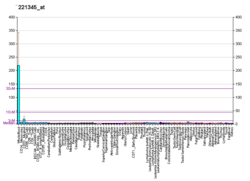Free fatty acid receptor 2 (FFAR2), also known as G-protein coupled receptor 43 (GPR43), is a rhodopsin-like G-protein coupled receptor (GPCR) encoded by the FFAR2 gene.[5] In humans, the FFAR2 gene is located on the long arm of chromosome 19 at position 13.12 (19q13.12).[6]
FFAR2, like other GPCRs, is located on the cell membrane and is activated by binding specific ligands, regulating various cellular functions.[7] FFAR2 is part of the free fatty acid receptor family, which also includes FFAR1 (GPR40), FFAR3 (GPR41), and FFAR4 (GPR120). FFAR2 and FFAR3 are activated by short-chain fatty acids (SCFAs), while FFAR1 and FFAR4 respond to long-chain fatty acids.[8][9]
SCFAs, produced by intestinal bacteria, play a key role in various bodily functions by activating FFAR2. This receptor is implicated in regulating insulin and glucose levels, inflammation, fat tissue development, and certain cancerous and non-cancerous cell growth.[10] Due to its role in these processes, FFAR2 has been studied for its potential involvement in conditions such as diabetes, inflammation, obesity, ketoacidosis, certain types of cancer, neurological diseases, and infections.[11][12]
Therapies targeting FFAR2 are being developed to modulate its activity in these conditions, offering potential new treatments for diseases influenced by SCFAs.[13]
- ^ a b c GRCh38: Ensembl release 89: ENSG00000126262 – Ensembl, May 2017
- ^ a b c GRCm38: Ensembl release 89: ENSMUSG00000051314 – Ensembl, May 2017
- ^ "Human PubMed Reference:". National Center for Biotechnology Information, U.S. National Library of Medicine.
- ^ "Mouse PubMed Reference:". National Center for Biotechnology Information, U.S. National Library of Medicine.
- ^ "Entrez Gene: FFAR1 free fatty acid receptor 1".
- ^ Kalis M, Levéen P, Lyssenko V, Almgren P, Groop L, Cilio CM (November 2007). "Variants in the FFAR1 gene are associated with beta cell function". PLOS ONE. 2 (11): e1090. Bibcode:2007PLoSO...2.1090K. doi:10.1371/journal.pone.0001090. PMC 2042513. PMID 17987108.
- ^ Weis WI, Kobilka BK (June 2018). "The Molecular Basis of G Protein-Coupled Receptor Activation". Annual Review of Biochemistry. 87: 897–919. doi:10.1146/annurev-biochem-060614-033910. PMC 6535337. PMID 29925258.
- ^ Karmokar PF, Moniri NH (December 2022). "Oncogenic signaling of the free-fatty acid receptors FFA1 and FFA4 in human breast carcinoma cells". Biochemical Pharmacology. 206: 115328. doi:10.1016/j.bcp.2022.115328. PMID 36309079.
- ^ Kimura I, Ichimura A, Ohue-Kitano R, Igarashi M (January 2020). "Free Fatty Acid Receptors in Health and Disease". Physiological Reviews. 100 (1): 171–210. doi:10.1152/physrev.00041.2018. PMID 31487233.
- ^ Ikeda T, Nishida A, Yamano M, Kimura I (November 2022). "Short-chain fatty acid receptors and gut microbiota as therapeutic targets in metabolic, immune, and neurological diseases". Pharmacology & Therapeutics. 239: 108273. doi:10.1016/j.pharmthera.2022.108273. PMID 36057320.
- ^ Loona DP, Das B, Kaur R, Kumar R, Yadav AK (2023). "Free Fatty Acid Receptors (FFARs): Emerging Therapeutic Targets for the Management of Diabetes Mellitus". Current Medicinal Chemistry. 30 (30): 3404–3440. doi:10.2174/0929867329666220927113614. PMID 36173072.
- ^ Mirzaei R, Bouzari B, Hosseini-Fard SR, Mazaheri M, Ahmadyousefi Y, Abdi M, et al. (July 2021). "Role of microbiota-derived short-chain fatty acids in nervous system disorders". Biomedicine & Pharmacotherapy. 139: 111661. doi:10.1016/j.biopha.2021.111661. PMID 34243604.
- ^ Schlatterer K, Peschel A, Kretschmer D (2021). "Short-Chain Fatty Acid and FFAR2 Activation - A New Option for Treating Infections?". Frontiers in Cellular and Infection Microbiology. 11: 785833. doi:10.3389/fcimb.2021.785833. PMC 8674814. PMID 34926327.




